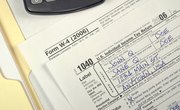
The U.S. tax system is "pay as you go," meaning workers make their payments throughout the year as they earn income. However, employers didn't always withhold money from pay checks. The system has been in use since the early 1940s, when the federal government was raising money for the expenses of World War II. Today, the amount withheld depends on the number of allowances or exemptions you claim on a W-4 form. Employers withhold the appropriate amount send the money directly to the Internal Revenue Service.
Tips
The modern tax withholding system began with the passage of the Current Tax Payment Act in 1943.
Payroll Tax Withholding
After the establishment of federal income tax in 1913, the government put in place a system of mandatory tax withholding. Complaints from employers about this system led to its repeal in 1917. During the 1930s, when the Social Security Act was passed, the government funded the new Social Security pension system through payroll tax withholding.
Wartime Revenues
Before the 1940s, taxpayers who owed federal income taxes paid them the following year, in quarterly installments. The financial burdens of World War II forced the government to raise more revenue, more frequently, throughout the year. As the federal budget rose tenfold during the war, from $9 billion in 1940 to $98 billion in 1945, Congress passed a law called the Current Tax Payment Act in 1943 to solve this problem.
Payroll Income Tax History
Tax withholding has continued uninterrupted since the passage of the Current Tax Payment Act. Employees have some control over the amount of income tax withheld, but payroll taxes are fixed and mandated by federal law. Social Security payroll withholding amounts to 12.4 percent of gross wages, split evenly between employers and employees (6.4 percent each). The IRS collects payroll taxes on behalf of the Social Security trust fund, which continues to pay for retirement and disability benefits. It collects Medicare tax at the rate of 1.45 percent on all earnings.
W-4 and Allowances
When you start a job, your employer will have you fill out a W-4. This form declares the number of allowances you are claiming, from zero to 10. Each represents an allowance based on yourself, a spouse and any dependents. You can claim exemption from withholding if you owed no tax in the previous year and expect to owe none in the current year. You can also claim zero allowances, which allows the employer to withhold the maximum amount for the IRS based on your pay, or request the employer withhold even more. This could help someone with additional self-employment income avoid a big bill at tax time.
References
- IRS: Publication 15, Employer's Tax Guide
- Time: How World War II Still Determines Your Tax Bill
- Society for Human Resource Management: SSA Revises Payroll Tax Cap for 2018; Tax Law Alters Rates and Brackets
- Cornell University: TOPN: Current Tax Payment Act of 1943
- Harry S. Truman Presidential Library and Museum: 175. Statement by the President – The Midyear Review of the Budget
- IRS. "FAQs on the 2020 Form W-4." Accessed Oct. 16, 2020.
- IRS. "Tax Withholding for Individuals." Accessed Oct. 16, 2020.
- IRS. "Topic No. 753 Form W-4—Employee's Withholding Allowance Certificate." Accessed Oct. 16, 2020.
- Social Security Administration. "Fact Sheet Social Security." Accessed Oct. 16, 2020.
- Social Security Administration. "Contribution And Benefit Base." Accessed Oct. 16, 2020.
- IRS. "Topic No. 608 Excess Social Security and RRTA Tax Withheld." Accessed Oct. 16, 2020.
- IRS. "Publication 531 (2019), Reporting Tip Income." Accessed Oct. 16, 2020.
- IRS. "Group-Term Life Insurance." Accessed Oct. 16, 2020.
- IRS. "Questions and Answers for the Additional Medicare Tax." Accessed Oct. 16, 2020.
Writer Bio
Founder/president of the innovative reference publisher The Archive LLC, Tom Streissguth has been a self-employed business owner, independent bookseller and freelance author in the school/library market. Holding a bachelor's degree from Yale, Streissguth has published more than 100 works of history, biography, current affairs and geography for young readers.

